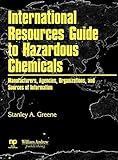What is an MSDS and why should you care?
Chemical Safety and MSDS sheets
I have been working in a laboratory environment for the last 15 years, and in my experience, staff become very complacent with the rules and regulations regarding basic safety when working with the same chemicals over and over again. When you work with dangerous chemicals on a regular basis, you begin to think that you know exactly how to handle them. That is not always the case. There are chemicals in every work environment that all staff members should be aware of. The federal agency OSHA (Occupational Safety and Health Administration) provides rules, regulations, and directives that governs the use of chemicals in the workplace. They mandate that employees are trained and familiar with potential hazards. This is called the "Right to Know Law". If you seriously think about it, there is no way the every staff member can remember all of the properties for each dangerous chemical in their environment.
Some workplaces can have upwards of 100 chemicals present at any given time. That is why the MSDS (Material Safety Data Sheet) is so important to understand. One of the rules that OSHA mandates, is the availability of the MSDS to all staff members at all times. This means that any harmful chemical you work with should have an information sheet available to you at all times, and you should know where they are. This Hub is being written to help you understand what an MSDS is and how to read the information provided there.
Each section of the MSDS gives different information, and each section is important to be able to completely understand the issues that may arise during the normal work day. Though MSDS's can vary greatly in their setup, they all contain the same basic information. So let's review the MSDS one section at a time!
Product Information/Substance Identification
This section holds information regarding the chemical and its molecular properties. It generally provides you with the molecular formula and molecular weight of the chemical, which to many employees will mean very little, but it also provides a list of common trade names and synonyms. Why is this helpful? Well often times, a chemical may be known one way by the employee (ie. formalin), but listed another way on the MSDS (ie. formaldehyde). In the event of a chemical spill or fire, the employee accessing the MSDS may need to utilize this section to help them make sure they have the right information.
Composition and Ingredients
Not all chemicals are created equal. Many toxic substances are combinations or mixtures of other dangerous chemicals. To identify all of the hazards present in a mixture, the MSDS sheet breaks the information down in this section. For example: Formalin is often made up of formaldehyde, water, and methanol. When separated these substances have different properties than they do mixed together. In certain situations, it is important to know all of the hazards that may be present in a given chemical.
Physical and Chemical Properties
One of the most important aspects of workplace safety is the prevention of accidents with chemicals. By reviewing the physical and chemical properties of a chemical, staff members can work with the chemical in a much safer manner and prevent larger problems from arising later. In this section the MSDS will describe what the chemical looks and smells like. It will also describe temperatures at which the chemical will boil (boiling point) and ignite (flash point). This is obviously important information if the workplace environment also utilizes open flames or other heat sources in their daily activities.
This section also contains information regarding solubility, specific gravity, vapor pressure, and pH. All of this information can give staff members a better idea of how to safely use the chemical in daily operations. No one person can possibly remember all of this data for every chemical used, and I don't believe that regulating agencies expect that. What they do expect, is that employees are trained in the use of chemicals before beginning to work with them. For example, Joe starts a job and is expected to use 4 different hazardous materials during a normal day. During his orientation the hazards of each chemical should be described to him in terms he can understand. "This chemical can't used or stored near sparks or fire" or "This chemical can explode if it comes into contact with water". He should be provided a copy of the MSDS to look over for more information, but training an employee should not consist only of handing him the MSDS and saying "Read it". Many of the terms and much of the information provided in an MSDS is technical wording that will provide no benefit to the staff member.
OSHA website: Here is where you can find the actual regulations, but be warned, they can often be very difficult to interpret in relation to specific industrie
- Occupational Safety and Health Administration - OSHA HOME PAGE
Occupational Safety and Health Administration Home Page
Fire and Explosion Data
While the previous section discusses specific properties of the chemical that are important to fire prevention, this section deals with information regarding what to do in the event of a real fire. Some information that may be included here are:
1) Fire fighting media - not all chemical fires should be handled the same way. Some are better handled with water while others with dry agents.
2) Whether toxic fumes may be given off when the chemical burns.
3) What other precautions may need to be taken before the fire department can arrive such as turning off electricity, shutting down gas valves, or air handling information.
4) Personal protective equipment necessary when dealing with the fire.
YouTube Video of Detriot Chemical Fire in 2007
Compatibility and Reactivity Data
Many chemicals are incompatible with other chemicals. If stored together or used in close proximity, the hazardous situation is amplified tremendously. This section of the MSDS is very important when many chemicals are stored or used within the same work environment. One example would be sulfuric acid and sodium hydroxide. Each of these chemicals are hazardous in their own right, but when they come into contact with each other they can react and cause an extreme amount of damage depending on the concentration and amount present.
Another factor to consider when looking at compatibility and reactivity of different chemicals is storage. If a chemical listed on the MSDS as being very corrosive to certain metals, it should not be stored in a container constructed out of those metals. Seems obvious, right? Well, it is, but only if someone took the time to read the MSDS sheet and gather that information beforehand.
Toxic Properties/Health Hazards
Chemicals can be toxic to the body in many different ways. There will always be a section in the MSDS that explains the different health effects and first aid procedures necessary if a person is exposed to the chemical. Exposure can occur in five main ways:
Inhalation
Eye Contact
Skin Contact
Ingestion
Injection
Depending on the route of exposure, concentration of chemical, and duration of exposure, chemicals can have different effects on the body. Using formaldehyde as an example, skin exposure for short duration may only cause irritation and rash, but at a high concentration or for a long period of time, it may cause blistering. Inhalation of formaldehyde for a brief period of time may only result in difficulty breathing, but over the long term, it may result in organ failure, sterility, and death.
Preventative Measures and Personal Protective Equipment
There is usually a section within the MSDS designated for information related to preventing exposure and accidents. This section will relay information on proper storage and handling of the chemical, as well as what personal protective equipment (PPE) should be worn when working with it. In certain instances, engineering controls may also be mentioned here. If a chemical needs to be handled in a chemical fume hood, or in a room with a certain type of air handling system, this is generally where you will find that information.
Spill or Release Procedures
The methods and materials used to clean up a chemical spill/release largely depends upon the size of the spill. Small spills can usually be safely cleaned up by staff members who have been appropriately trained to handle the chemical. In the case of extremely large spills, it is often necessary to call in an internal safety advisor or an outside contracting agency. Local fire departments often have personnel specifically trained to deal with hazardous spills called a Hazmat Team. This section of the MSDS sheet can be extremely useful to both the internal staff and any outside personnel helping with clean up procedures.
Chemical Waste Disposal
After a chemical is used, the waste generated needs to be discarded. The MSDS will give some general guidelines regarding waste removal, but most often it will just state that one should follow local, state, and federal regulations. The reason for this is because the regulations regarding hazardous waste disposal differs greatly depending on location. The best way to get the most up to date information for disposal of your waste would be to call your local environmental quality office for guidance.
It is important to remember when working with chemicals that accident prevention is key, but if a chemical incident occurs safety should be your top priority. MSDS sheets are designed to help in both of these key areas.








